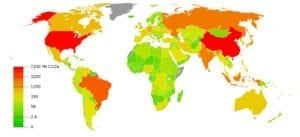
Ammonium salts could provide a viable way of removing carbon dioxide from the atmosphere via carbon mineralization
Removing excess carbon dioxide (CO2) from the atmosphere may be essential to curb severe climate change. Possible, but expensive, methods include burying the gas underground between rock layers or ‘scrubbing’ the CO2 in power station cooling towers before it is released. James Highfield at A*STAR’s Institute of Chemical and Engineering Sciences, together with co-workers at the National Junior College of Singapore and Åbo Akademi University in Finland, has now described a cheaper and more permanent solution that would prevent the CO2 escaping back into the atmosphere1,2.
Their work focused on using carbon mineralization, a process that involves a reaction between CO2 and minerals, such as magnesium silicates, to form solid carbonates. Mineralization occurs naturally between the atmosphere and rocks, and the carbonates remain geologically stable for millions of years. Crucially, plentiful raw materials would be available to conduct this type of CO2 removal on a vast scale.
Natural carbon mineralization is very slow, so scientists are working to accelerate the process in an energy-efficient and carbon-neutral way. Using ammonium salts and magnesium-silicate-rich serpentine rocks, Highfield and co-workers induced rapid carbon mineralization. They also found that milling the solids could convert serpentine directly into stable carbonate.
To accelerate the extraction of magnesium (as soluble sulfate) from serpentine, the researchers used ammonium sulfate. This reaction generates by-products such as iron oxide that may be useful for the steel industry. They trapped the leftover ammonia in water, and recycled this by-product in an aqueous wash with the magnesium solution to produce a mineral form of magnesium hydroxide called brucite. Finally, the researchers carbonated the brucite in a pressurized reactor. The heat generated by this exothermic process was recycled to help power the initial magnesium extraction.
A key aim throughout the processing was to recycle as much ammonium sulfate as possible. The final products, magnesites (magnesium carbonates), could also be useful. “Magnesites are commodities in their own right as smoke- and fire-retardants, and have potential for heavy-metal ion sequestration,” the team notes.
The Latest Bing News on:
Carbon capture
- Decarbonize, Don’t Deindustrialize: Why Illinois Needs Carbon Captureon May 9, 2024 at 7:14 am
Passing legislation that further enables the deployment of these technologies in Illinois would be the first step in delivering this for hard-working people. Lawmakers from across Illinois have already introduced legislation that promises to further unlock this technology across our state.
- Offshore carbon storage near Houston delayed but could open up by end of 2024on May 9, 2024 at 3:00 am
Houston could benefit from offshore carbon sequestration, but the industry is waiting on the federal government.
The Latest Google Headlines on:
Carbon capture
[google_news title=”” keyword=”Carbon capture” num_posts=”10″ blurb_length=”0″ show_thumb=”left”]
The Latest Bing News on:
Removing carbon dioxide from the atmosphere
- The world’s biggest carbon removal plant comes online in Icelandon May 9, 2024 at 12:08 am
The plant is a critical step in the race to remove billions of tons of carbon a year by mid-century, a move that will likely be needed to keep global warming to relatively safe levels.
- The world’s largest carbon removal plant is here, and bigger ones are on the wayon May 8, 2024 at 12:00 pm
Carbon dioxide removal is an umbrella term for a suite of technologies being developed to take carbon dioxide out of the atmosphere. These technologies could potentially help slow ...
- The world’s biggest carbon removal factory just opened in Icelandon May 8, 2024 at 8:00 am
Climeworks’ plant will have the capacity to capture around 36,000 tons of CO2 per year. In 2021, the first large-scale carbon removal plant started sucking CO2 from the air in a remote corner of ...
- KELP BLUE NAMED AS A FINALIST FOR THE PRESTIGIOUS XPRIZE CARBON REMOVAL COMPETITIONon May 8, 2024 at 6:00 am
Kelp Blue, an innovative seaweed company that seeks to restore marine biodiversity and promote carbon sequestration to support a healthier ocean ecosystem, was today named as one of 20 finalists by ...
- Veolia Uses Enzymes in World-First Trial to Remove Carbon Dioxide with Enhanced Rock Weatheringon May 8, 2024 at 2:45 am
Veolia, the UK’s leading resource management company, has partnered with UK biotechnology startup, FabricNano, to apply enzymes to rocks to trial faster, permanent carbon dioxide removal directly from ...
- Captura Advances to the Top 20 Finalists in XPRIZE Carbon Removal Competitionon May 8, 2024 at 1:01 am
Captura’s inclusion on the list – one of only four ocean-based solutions – highlights the great potential of its Direct Ocean Capture (DOC) technology to remove carbon dioxide (CO 2) from the ...
- Global climate policies lack ambition to remove carbon dioxide, study sayson May 6, 2024 at 7:26 am
Researchers found that the world has much more work to do — both in carbon removal and emission reduction — to meet the Paris Agreement's deadline.
- 'Gap' in carbon removal: Countries' plans to remove CO2 not enoughon May 3, 2024 at 9:35 am
New research suggests that countries' current plans to remove CO2 from the atmosphere will not be enough to comply with the 1.5 C warming limit set out under the Paris Agreement.
- Research indicates that carbon dioxide removal plans will not be enough to meet Paris treaty goalson May 3, 2024 at 9:11 am
New research indicates a large “emissions gap” between what actions nations have committed to help remove carbon from the atmosphere and what’s required to meet Paris treaty goals.
- IDTechEx Release New Global Carbon Dioxide Removal Market Reporton April 25, 2024 at 5:30 am
BOSTON , April 25, 2024 /PRNewswire/ -- IDTechEx, a trusted provider of independent market intelligence, announces the availability of a new report, "Carbon Dioxide Removal (CDR) 2024-2044 ...
The Latest Google Headlines on:
Removing carbon dioxide from the atmosphere
[google_news title=”” keyword=”removing carbon dioxide from the atmosphere” num_posts=”10″ blurb_length=”0″ show_thumb=”left”]











